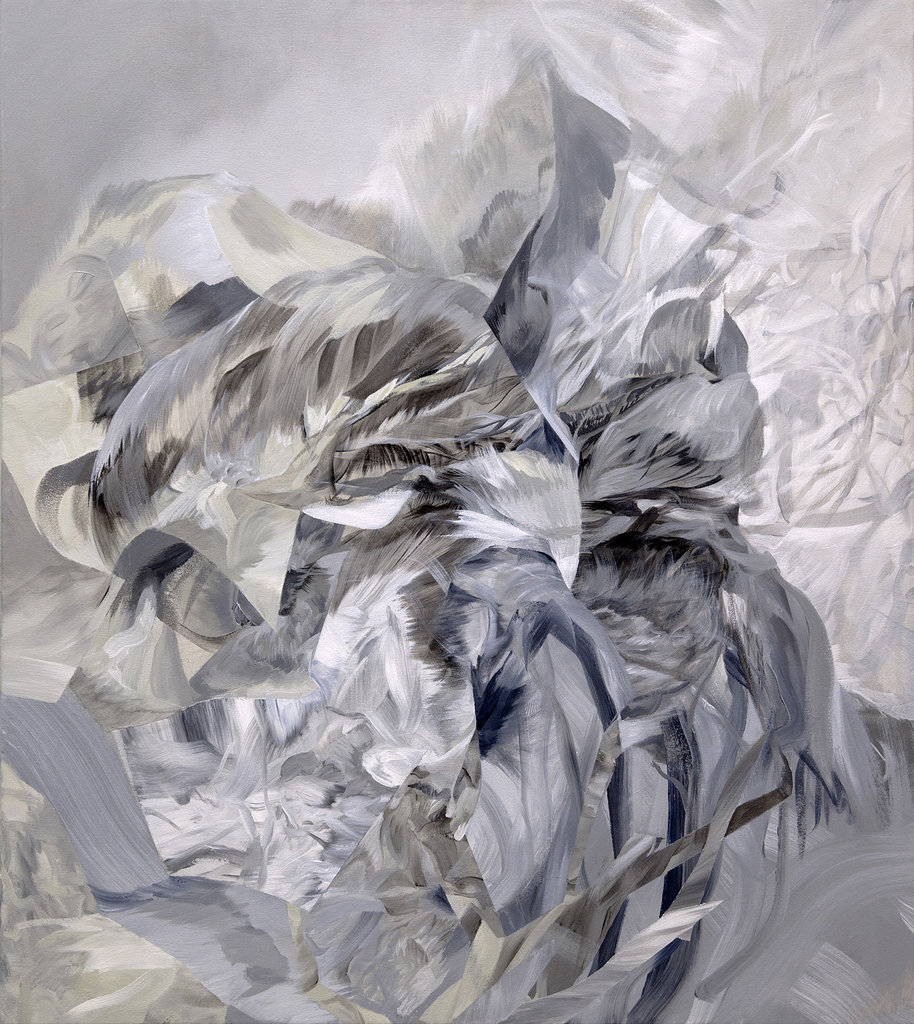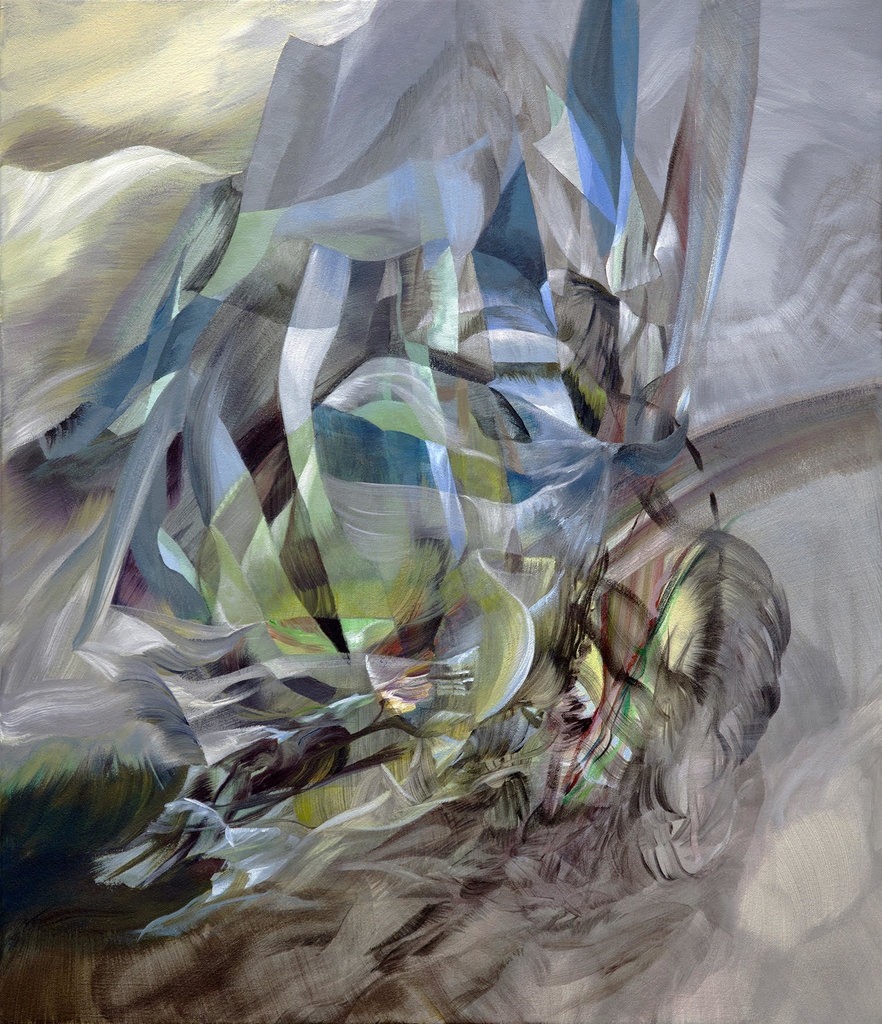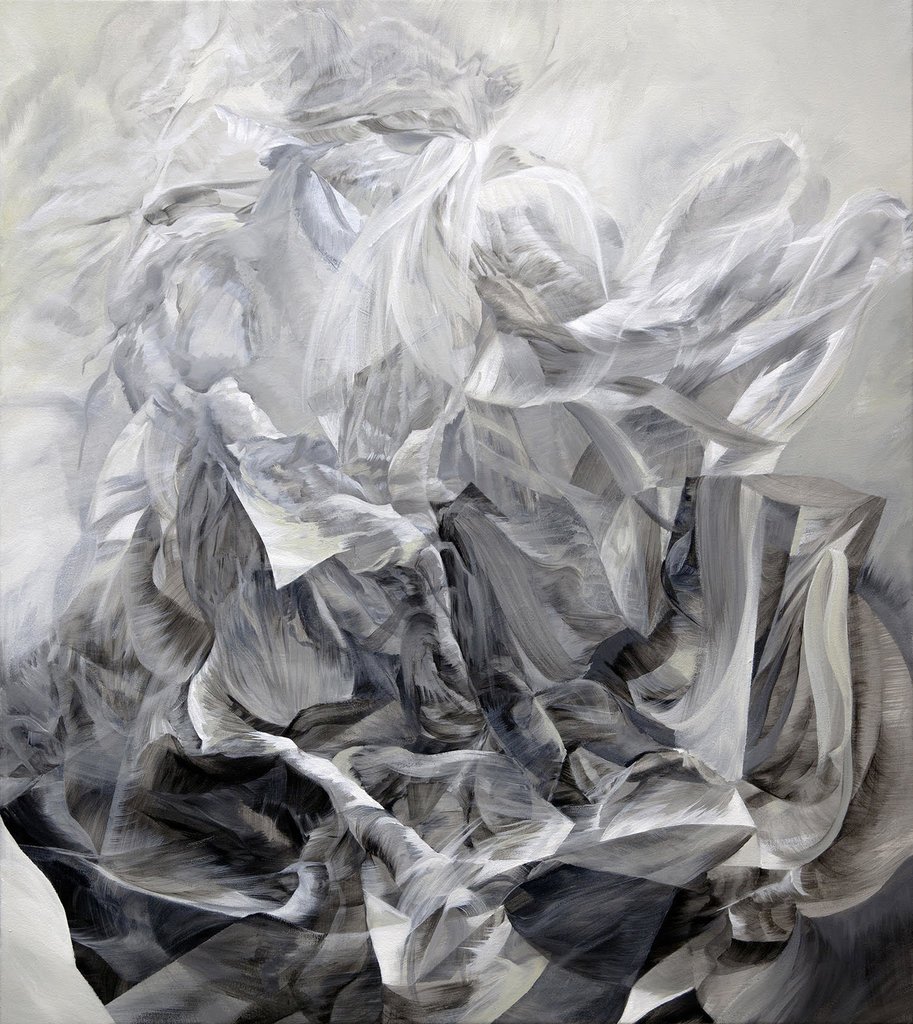On entering the exhibition space the visitor is immediately struck by the seductive beauty of the nine medium-sized paintings on display. Each one draws you in. But on closer inspection you are thrown back out onto the surface. Every attempt to interpret the piece is frustrated. At first glance the grey-toned compostion titled Staggered Acts, for example, is suggestive of a mountain view. But this image soon dissolves before your eyes, bringing you back to the thinly applied acrylic paint on the canvas. Other interpretations cross your mind but none of them stick. This experience heightens the paintings’ allure. These are games Authier deliberately plays with the viewer. In a published interview she explicitly states that that is her strategy.
Melanie Authier, Staggered Acts, 2018, acrylic on canvas, 36 x 32 inches
Her approach is greatly influenced by the ideas of art historian James Elkins. Elkins offers a radical interpretation of painting as alchemy. It is alchemical in the sense that the painter aims to turn liquid into Stone, i.e., something solid (see his What Painting Is, 2000). And just as real alchemists necessarily got their hands dirty transforming substances, so the painter must by trial and error manipulate liquid paint to transform it, to create the illusion of space among other effects. Authier consciously perceives herself as doing just that. It is this physically-grounded process that is her central concern as a painter. Paint is her prima materia.
Yet Authier also claims that she paints far more pictures in her head than she actually produces. How is this possible if painting is for her an ineluctably physical process? Here she is telling us that her starting point is some mental image. Her attempts to realize it physically quickly encounter the material reality of the painting process. As a result the painted image will inevitably stray from her preconceptions. This description of the painting process recalls that of Italian philosopher Benedetto Croce. But Croce makes the stronger assertion that the painter does not possess locked inside her head a fully formed mental image, one from which she will stray. An image exists insofar as it is an expression in paint. The painter starts with a feeling and struggles to express it, and she knows when she has succeeded. It is feeling – the result of reflecting on one’s overall interaction with the world – that the painter aims to express. The painter, then, has our attention to the degree that the feelings she expresses hold us. We are gripped by Picasso’s Guernica, for example, in virtue of the power of his feelings, his moral outrage, his sense of tragedy etc., as well as because of his success in expressing them.
Melanie Authier, Ten Arm Tango, 2018, acrylic on canvas, 28 x 24 inches
Of course, abstract paintings too can express feeling in this sense. But I’m not sure what Authier’s paintings are an expression of. She characterises her working method as involving a conversation between herself and the process of painting. As such she deliberately isolates herself from outside distractions during the times when she is immersed in her work. What inspires her, it seems, are her visual experiences in all their variety – the mundane and the extraordinary. She describes how her attention was particularly caught by the sight resulting from a wine glass falling from her hand and smashing on the floor. More generally she is arrested by textures, patterns, reflections and so on. Indeed, a painting such as her Ten Arm Tango does relate to such experiences. There is a wonderful sense of texture, light and colour produced by the layering of diaphanous veils of paint, folding in on each other. But what feelings do we glean from looking at this painting? It is not clear.
Melanie Authier, Sentinel, 2018, acrylic on canvas, 36 x 32 inches
There is little doubt that her principal concerns are formal – colour, the illusion of space and texture – these are the things that appear to excite her interest. She is an alchemist enthralled by the processes themselves by which she hopes to turn liquid into solid. As such she is a technical master. This mastery is evidenced by her ability to render formal qualities into a beautiful whole. When looking at a painting like Sentinel one cannot help but delight in its symphony of painted illusion. Her paintings are all about surface in this sense. That is where their lyricism lies.
Hugh Alcock
Images are courtesy of Georgia Scherman Project
*Exhibition information: Melanie Authier, Amplitude of the Infinite, October 19 – November 17, 2018, Georgia Scherman Projects, 133 Tecumseth St, Toronto. Gallery hours: Tue – Fri 10 am – 5 pm, Sat 11 am – 5 pm.



